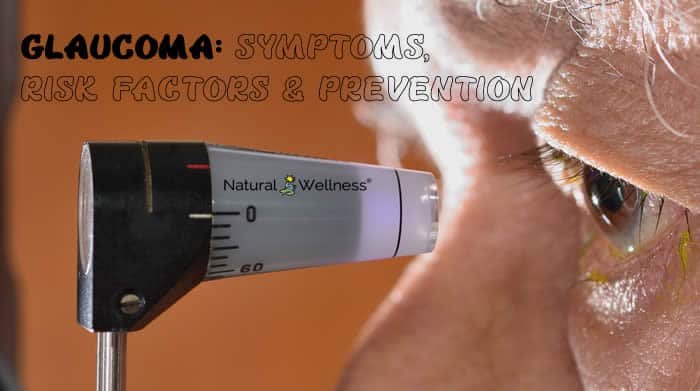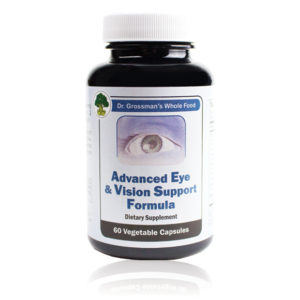

January is Glaucoma Awareness Month.
When you’re dealing with glaucoma, you’re dealing with damage to your optic nerve. This nerve is important for keeping good vision and is caused by high amounts of pressure in your eye. Glaucoma is one of the leading causes of blindness in people who are over the age of 60, but it can occur at any age. (1)
Just because you’re getting older doesn’t mean that your eye health has to decline. When you maintain and feed your eyes key nutrients, conditions like glaucoma could be avoided.
Symptoms of Glaucoma
Oftentimes glaucoma doesn’t even show itself right away. Therefore about half of people with glaucoma don’t even know they have it. With glaucoma, your vision begins to fade away slowly. It can often start with your peripheral, or side, vision next to your nose. At first, that slight change in vision may not be noticeable, but over time and without treatment, more side vision would go away and eventually lead to blindness. (2)
There are different types of glaucoma, but 9 out of 10 times it is open-angle glaucoma. (3)
Symptoms for this include:
- Patchy blind spots in your side or central vision, oftentimes in both eyes
- Tunnel vision in advanced stages
Acute-closure glaucoma is less common, but it’s also a medical emergency. You should go to the doctor or emergency room immediately if you have the following symptoms:
- Intense pain in your eye
- Nausea
- Red eyes
- Blurred vision
9 Risk Factors
Some of us have a higher risk of contracting glaucoma and other eye diseases than others. Chronic forms of glaucoma have the capability of destroying vision before the signs and symptoms are noticeable, so it’s important to know if you have the risk factors.
They include: (1)
- Having high internal eye pressure (intraocular pressure)
- Being over age 60
- Being black, Asian, or Hispanic
- Having a family history of glaucoma
- Having certain medical conditions, including diabetes, heart disease, high blood pressure, and sickle cell anemia
- Having corneas that are thin in the center
- Being extremely nearsighted or farsighted
- Having had an eye injury or certain types of eye surgery
- Taking corticosteroid medications, especially eyedrops, for a long period of time
Prevention
Knowing the risk factors of glaucoma is one major step toward prevention, but there are other specific things that can be done to keep your eyes in tip-top health.
The best thing you can do is get regular eye exams to get early detection.

Glaucoma Research Foundation (4) recommends following this exam schedule:
- Every 2 to 4 years before age of 40
- Every 1 to 3 years from age 40 to 54
- Every 1 to 2 years from age 55 to 64
- Every 6 to 12 months after age 65
If you do have high risk factors, you should be tested every 1 to 2 years after age 35.
Staying physically active on a consistent basis can also keep your eyes nice and healthy, plus benefit overall health. Moderate amounts of exercise, such as walking or jogging 3 or more times every week, has been shown to reduce intraocular pressure (IOP) which can damage the optic nerve.
Protecting your eyes from injury is also important to prevent further damage. If you’re playing sports with regular physical contact or making home improvements, be sure to wear protective eyewear.
Supplementation
Unfortunately, once glaucoma damage happens it cannot be reversed. That’s why it’s important to stay on top of your eye health. Natural Wellness supplies an Advanced Eye & Vision Support Formula to promote clear vision and healthy eyes.
The blend contains:
- Organic prickly pear
- Organic bilberry
- Organic carrot
- Organic turmeric
- Organic spinach
- Organic chlorella
- Organic tomato
Studies Have Shown
Studies have shown that many of these ingredients support eye health. A 2020 study published in the Journal of Clinical Biochemistry and Nutrition (5) found that subjects with open-angle glaucoma had reduced intraocular pressure after taking supplements containing bilberry fruit for 4 weeks.
The addition of carrots and spinach gives you a vitamin A boost, which has been widely studied on its ability to support vision. One study in particular published in Nutrition (6) shows that vitamin A and its beta-carotene counterpart helps protect against cataracts.
Curcumin (a naturally occurring compound found in turmeric) has also had its fair share of research on how beneficial it is for eye health. One 2019 study published in Central European Journal of Immunology (7) states that curcumin is an antioxidant and anti-inflammatory agent, and is effective in preventing major eye diseases, including:
- Glaucoma
- Cataracts
- Age-related macular degeneration
- Diabetic retinopathy
- Corneal neovascularization (invasion of new blood vessels in the cornea)
- Corneal wound healing
- Dry eye disease
- Conjunctivitis (AKA pink eye, inflammation of the white parts of your eye)
- Pterygium (tissue growth on the cornea of the eye)
- Anterior uveitis (inflammation of middle layer of the eye)
The last 2 ingredients in the Advanced Eye & Vision Support Formula are lutein and zeaxanthin. Along with the superior support blend, studies have shown they play an important role in eye health.
One study published in the Annual Review of Nutrition (8) states they help with:
- Ocular development throughout the lifespan
- Vision performance in young and later adulthood
- Lowering risk of developing common age-related eye diseases
Conclusion
Staying up to date with eye appointments is going to be your best chance at catching any potential eye problems. And it never hurts to continue to provide your eyes the nutrients they need to thrive and prevent future complications.





